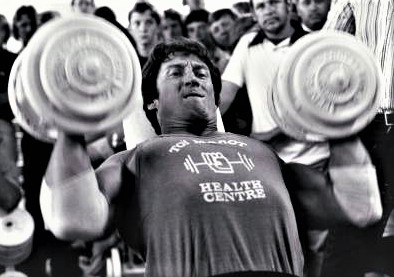If there were a single best way to train it would be with dumbbells. The balancing act they provide during an upper body workout, taxes and develops the muscles from all angles and gives superior development. I learned this when I was a young teenager just starting weight training.
I’d saved my money and spent $25 on a set of adjustable dumbbells that went up to 15 pounds each and began training upper body three times a week after school in my cellar. Previous attempts of working out doing mainly wide grip bench press (at age 14 I was doing 12 reps with 125) curls and wide grip chin-ups yielded no visible results. But after just two weeks of flyes, pullovers, rows, presses, curls, and lateral raise I had muscles popping out all over. I invested in a bunch of tight black and light blue T shirts and began walking around with my lats flexed at all times. I was getting so wide I had to walk through doors sideways I thought, entertaining the notion that if I did a lat spread in a stiff breeze the wind would pick me up off the ground. My lats were developing.
I did three sets of 10 reps with incline dumbbell press, dumbbell flye, dumbbell pullovers, overhead press, curls, side and bent over lateral raises, kickbacks, and one arm extensions. Along with sit-ups and leg raises and the squatting I started doing with a barbell three times a week, I began building an impressive physique.
That’s how my training started, and I’ve used dumbbells ever since. Dumbbells are the best because they work each side of your upper body independently. A great deal of control and balance must be learned to negotiate a successful dumbbell workout. Little shifts in the movement produces a different effect on the muscles, working different areas in diverse ways. Dumbbells build muscle shape.
The problem with barbell work is that gripping a bar forces the hands into a fixed position devoid of pronation and suppination since you can’t turn the wrists. This can cause strain on the inner wrist with wide grip, outer wrist with narrow grips, and potential for inner and outer elbow injury especially when heavier weights are used. It’s much better to substitute dumbbells for the same barbell exercises. It will force you to use lighter weights so do higher reps. You will get a better pump and stretch to the areas you are exercising.
Here’s a really good dumbbell workout which can be done one, two, or three times a week depending on your age, resilience, and goals:
Bent over dumbbell row
45-degree incline dumbbell press
Bent over lateral raise
10 degree decline dumbbell fly
Two arm dumbbell pullover
One arm dumbbell extension
One arm dumbbell curl
One arm dumbbell side raise
Leg raises. crunches, and seated twists for abdominals are exercises I’ve relied upon for many years. You need almost no equipment to work abs, just a bench to sit on for seated twist and a 5-foot pole. 100 reps on leg raises and crunches done in sets of 25 to 50 reps in super set fashion followed by 100 seated twists give a thorough waistline workout.
In my early training years, I did squats holding a dumbbell in each hand with my heels elevated on a 2 by 4-inch block. I’d go deep into the squat and not come up all the way, only about 2/3 thereby keeping tension on the quads. Super set stiff legged dead-lifts with a dumbbell in each hand and have a decent thigh workout. An ever more challenging way to squat is the sissy squat holding on to a doorknob as described on page 11.
Lunges with dumbbells is a good quad/hamstring exercise. Calf work can be quite simple, all you need to do is stand on a step, hold a dumbbell in one hand and balance with the other hand, stretch all the way down and hold for one second when heel is all the way up. Alternate feet for 3 sets of 15 reps with each leg.
You can train your entire body with dumbbells.


